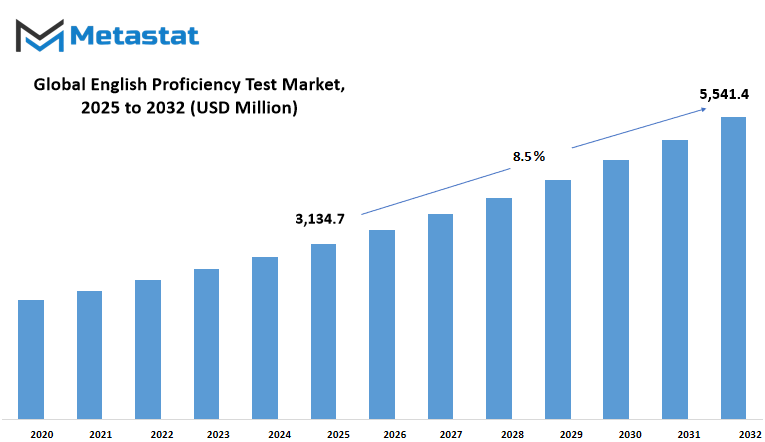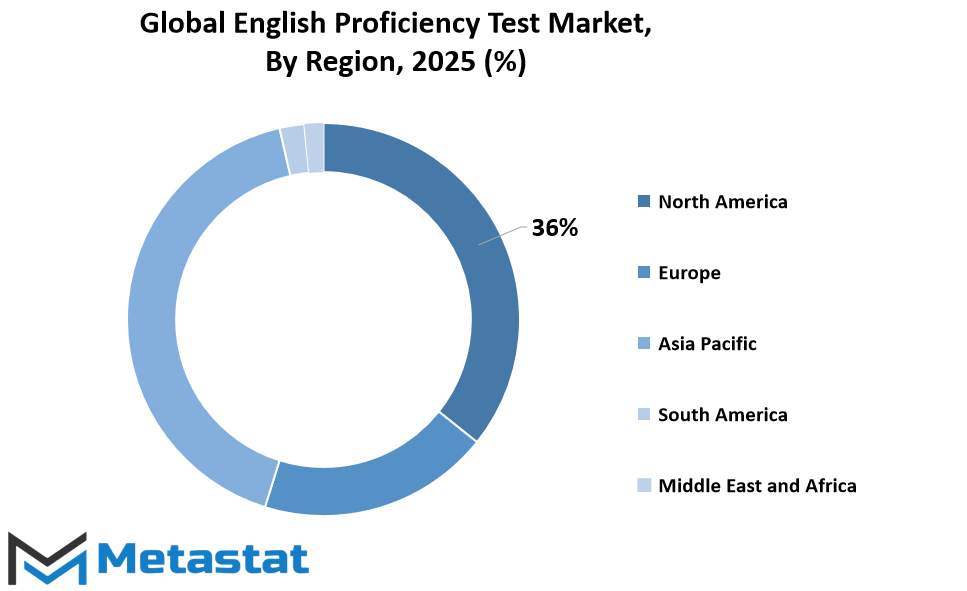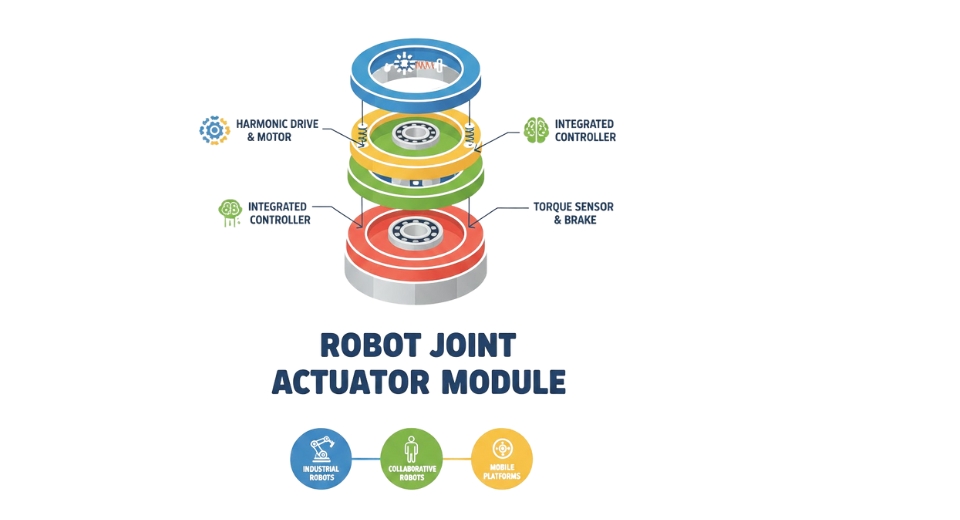MARKET OVERVIEW
The global English proficiency test market is molding a sector that is far broader than the conventional language tests, redefining how individuals, institutions, and firms approach linguistic ability in today's globalized world. As educational infrastructures and global mobility become increasingly integrated, the role of English proficiency will only spread farther, not only as an add-on to their linguistic capital but as a strategic resource for professional, academic, and digital landscapes. The market for Global English Proficiency Test is now no longer confined to traditional paper-based or computer-adaptive tests conducted by students applying for admissions or jobs overseas. It is evolving into a larger ecosystem that will affect corporate upskilling, immigration policy, and even how digital platforms design content accessibility between languages.
In the near future, the global English proficiency test market will experience further integration with AI platforms that optimize learning experience and monitor user performance in real time. This will alter the expectations around such tests, moving them away from rigid models towards more adaptable, user-dependent forms. Applicants will not only be tested for vocabulary and grammar but for context-based understanding, cultural competence, and practical use of language in online and working lives. Further, institutions implementing these tests will begin to appreciate such fluid gauges over fixed scores, thereby changing the way talent gets sifted across the world.
What is in store is a demography transformation in this market. It will increasingly appeal to professionals looking for cross-border mobility, gig workers in global markets, and even retired ones considering relocation. As economies are further digitalized, business houses will require an employee base that can move effortlessly in English, not only with customers but between remote units and global projects. The global English proficiency test market will become critically important in determining who becomes eligible for these positions, setting new standards for communication superiority. Language competencies will no longer be considered ancillary or voluntary but as essential to personal ability and employability.
The other aspect that will evolve is the localization of international testing systems. Rather than one-size-fits-all examinations, regions will start to tailor proficiency tests to suit regional colloquialisms, societal idiosyncrasies, and industry-specific communications. In the process, the global English proficiency test market will obscure the lines between education and assessment. Preparation for the test itself will transform into an experiential process integrated into daily tools such as virtual assistants, productivity apps, and mobile apps. It will no longer be exclusive to test-takers but will bring educators, content developers, and app developers together in a common space of language innovation.
As the world goes on to engage with each other beyond borders and screens, English will remain a unifying thread. But what we assess proficiency by will see a change catalyzed by changing expectations and growing use-cases. The market for Global English Proficiency Tests will sit at the crossroads of this change, providing more than scores providing validation, access, and opportunity to those ready for the future of communication.
Global English proficiency test market is estimated to reach $5,541.4 Million by 2032; growing at a CAGR of 8.5% from 2025 to 2032.

GROWTH FACTORS
The global English proficiency test market is taking solid strides as English communication needs keep increasing beyond boundaries. One of the main reasons behind its development is the increasing number of students and working professionals in search of international opportunities. Whether someone is doing higher studies in foreign universities or targeting jobs in multinational companies, English proficiency is a condition. This also pushes the demand for standardized tests to assess the language ability higher. Secondly, most corporations are making English their in-house language for communication, again urging the employees to demonstrate their command through these tests.
But the global English proficiency test market does have some limitations. The cost of appearing for these tests is very high, particularly from the developing nations. These charges tend to be prohibitive, and many would-be test-takers find it hard to take them. Another problem is the weak digital infrastructure in rural and off-grid areas. Given that an increasing number of tests are now accessible online, poor internet connectivity complicates it for candidates in such regions to sit for them without technical impediments.
There are bright prospects, regardless of these problems. The test market can expand a great deal by targeting areas with a burgeoning population of English language learners. As increasingly more individuals in developing economies realize the importance of learning English for academic progress and career development, the test market will continue to grow. Another source of optimism is technology. AI-powered solutions are bringing revolution in testing design and delivery. These developments have the ability to make the test more adaptive, cost-effective and convenient, and can reduce costs and increase overall user experience.
MARKET SEGMENTATION
By Testing System
The global English proficiency test market has experienced a significant boom in the last few years, and it would continue to do so. With verbal exchange more and more on the heart of expert and educational fulfillment, the want for standardized English language trying out will continue to boom. Students, working professionals, and immigrants normally require proof of English competency to be eligible for admissions, employment, or immigration to English-speaking countries. These demands gas the call for for such exams as IELTS, TOEFL, and others, each used for truly distinctive functions relying on country and intent.
Among the systems available for testing, IELTS takes the top position with a value of $1,487.5 million. This is a testament to its vast acceptance by academic institutions and governments around the world. TOEFL is also a dominant force, particularly in North America, while other local tests are on the rise in some markets. Despite competition among the tests being evident, they have a common objective the measuring of a candidate's capacity to comprehend, utilize, and communicate orally in English.
The format of such tests, with reading, writing, listening, and speaking sections, makes it possible to test language ability in practical contexts. This makes them authentic in the eyes of institutions and employers. Furthermore, the progress of technology is also pushing these tests closer to people, with online testing becoming the norm. Not only does this make it easier for users to take tests from where they are, but it also simplifies administrative functions.
The global English proficiency test market also has some problems. Availability is still a problem in remote communities, where internet connectivity and exposure might still be poor. Further, the expense of sitting for these examinations can be prohibitive for those in developing nations, tending to become an economic hardship. In spite of these barriers, exposure is increasing, and more assistance services, including complimentary preparation software and language schools, are emerging to simplify the procedure.
In the immediate future, the market will expand as well due to increased international mobility and globalized education. Partnerships with governments, academic relationships, and business training demands will drive growth. The focus on communication as a life skill will continue to drive demand for assessment systems that can equally and effectively assess English proficiency.
By Mode of Test
The global English proficiency test market is defined by increasing demand in education, employment, and migration industries. With the relevance of English proficiency increasing continually, individuals and institutions are seeking formal assessment to quantify and verify language ability. These tests are more than an evaluation tool as they become gatekeepers of academic opportunities, foreign work prospects, and visa grants. Preference for such assessments has evolved right away over the previous few years, mainly as globalization intensifies humans' verbal exchange throughout exceptional linguistic backgrounds.
On the basis of mode of take a look at, the marketplace is segmented into on line and offline segments. Both modes have their own enchantment based totally on users' needs and nearby infrastructure. The online mode is popularizing due to its convenience, flexibility, and multiplied accessibility. Candidates are capable of choose their comfort of time and region in many cases, reducing down on journey and administrative hassles. With improved digital presence in education and expert certifications, on line modes are increasingly being chosen in view that they allow far off proctoring with live monitoring and quicker end result processing. Conversely, offline checks remain relied upon in regions wherein net connectivity is unreliable or establishments need a stable take a look at surroundings. For maximum candidates, being seated in a formal check middle introduces an air of subject and seriousness that favors focused overall performance.
Both fashions are probably to exist side via facet for the foreseeable future, every pleasurable disparate consumer businesses and institutional desires. Test builders are striving to improve both reviews improving digital security and usefulness in on line environments, while refining the consolation and assist offered in offline facilities. With an growing call for for English abilities certification, particularly from non-local English-talking countries, a balance of offline and online options will determine the quantity to which and the way correctly these exams penetrate global check-takers.
By Application
The global English proficiency test market is slowly growing as demand for English as a primary tool for communications keeps on escalating in different sectors. Perhaps the maximum crucial part of this improvement is the way the marketplace is segmented on the idea of software. That is, the marketplace is broken down in addition into Graduates/Undergraduates, Employers, and Others, every representing a distinct set of requirements and expectations.
For students, especially graduates and undergraduates, those assessments serve as doorways to educational guides, scholarships, and employment possibilities overseas. Institutions of studying in those countries in which English is the language of instruction frequently mandate that candidates have some degree of language talent. This demand via itself will hold on fueling high uptake in this category, especially as global schooling mobility turns into more on hand and promoted.
While employers apprehend English talent as a signal of professional preparedness. In an increasingly without boundaries commercial enterprise network, the ability to communicate and comprehend in English can make or damage the in shape of a candidate. Several firms these days use these checks as a part of their hiring or promoting technique, specially in sectors such as customer support, technology, healthcare, and finance, where international customers and groups need to be interacted with. This class will maintain to amplify steadily as the arena's agencies emerge as more and more global and appearance to rent staff who can confidently serve as their representatives in a variety of environments.
The "Others" category generates a larger user base. This group may consist of individuals looking for immigration, professionals seeking skill certification, or even governments leveraging test results for national benchmarking. With language learning becoming more embedded in goals around personal development, the inclusion of this category indicates usage cases extending beyond what was historically found through traditional education or employment paths.
Together, these uses create a picture of a market that is still growing to meet needs in the world. Whether it's for academic endeavor, career development, or individual development, English language testing has become a stepping point to greater things. As each of these categories continues to grow in application, the global English proficiency test market stands ready to address a diverse and consistently growing need.
|
Forecast Period |
2025-2032 |
|
Market Size in 2025 |
$3,134.7 million |
|
Market Size by 2032 |
$5,541.4 Million |
|
Growth Rate from 2025 to 2032 |
8.5% |
|
Base Year |
2024 |
|
Regions Covered |
North America, Europe, Asia-Pacific, South America, Middle East & Africa |
REGIONAL ANALYSIS
The global English proficiency test market has attracted growing interest as more individuals look for global academic, professional, and immigration opportunities. English remains an accepted language worldwide, and testing services are assisting institutions and employers to determine language skills with accuracy. These tests for college entry, job placement, or immigration purposes have become essential tools in determining language capability in real-life contexts. As digital transformation comes close to affecting almost every industry, the availability and structure of English tests are also moving towards more flexible, online-based forms that align with contemporary lifestyle.
Geographically, the global English proficiency test market environment is segmented into a number of main regions contributing to its growth differently. North America, for example, experiences strong demand primarily due to the U.S., Canada, and Mexico. These nations are home to leading universities and multinational organizations, both of which demand applicants to present good English language skill. The standards of education in the region and immigration policies also drive the demand for recognized proficiency tests, thus supporting steady market demand.
In Europe, the UK, Germany, France, Italy, and others are in a mature test environment. These nations have structured education systems and standardized tests. International students and the mobile labor force have also maintained the demand for English tests. Employers and universities still require evident evidence of language proficiency and use the scores of such tests to make important decisions.
Asia-Pacific is a whole different pace. With big populations and an increasing focus on English education, India, China, Japan, and South Korea are driving the market. For these countries, English is a passport to world opportunities. Whether it is securing entry into a foreign university or remaining competitive in a tough job market, young professionals and students alike are increasingly spending money on test prep and certifications. As the region becomes increasingly integrated into global systems, demand for these tests will be stable and robust.
In South America, countries like Brazil and Argentina are moving forward consistently. English education is spreading to schools and workplaces, especially among younger generations that are more worldly connected. The demand for these tests is increasing not just for work and travel purposes but also to fulfill foreign employers' and institutions' requirements. With this trend, more testing sites and electronic formats will be made available to cater to rural as well as urban communities.
The Middle East & Africa region comprises a list of countries such as those in the GCC, Egypt, and South Africa, with drivers of demand for each of these countries. English acts as a second language in academic as well as business sectors. English proficiency testing is now becoming a norm for an increasing number of students who come from these regions to study abroad. Governments and private sectors are also promoting language development programs, hence driving the market towards steady growth.
The global English proficiency test market by Metastat Insight mirrors not only the increasing demand for measurement of language but also the increasing availability of global platforms for work and education. There is a unique set of cultural and institutional requirements in each region, but all of them identify the utility of English as a common communication device. With increasing global connections and movement, the importance of these tests will continue to increase, solidifying their position in personal and professional growth.

COMPETITIVE PLAYERS
The global English proficiency test market has emerged as an essential component of global education and employment systems, with millions of students and professionals turning to such tests in order to access new possibilities. As English remains a bridge between borders, the need for authentic, standardized testing has constantly been on the rise. This boom is not merely approximately academic access or career placement it's also about social mobility and worldwide accessibility. People in non-English-speaking regions now see language certification as a necessity, now not a luxury, to participate in nowadays interconnected global.
Technology has played a main position in making those exams greater to be had. What was as soon as limited to traditional lecture rooms or physical trying out facilities is now accessible online, giving applicants the flexibility to put together and take assessments from their personal houses. This alternate has promoted a tide of innovation, forcing take a look at makers to develop friendlier systems and adaptive studying structures. The ease element by myself has made online trying out rather popular, specifically amongst operating experts and students with stressful schedules.
Multiple providers are influencing the form and improvement of this market. Well-known names including Berlitz Corporation, EF Education First, Pearson PTE, and Educational Testing Service (ETS) retain to provide respectable certifications. Institutions including the British Council, Transparent Language, Inc., and Wall Street English International also exercising a robust presence thru their well-diagnosed programs international. On the other hand, Cambridge University Press & Assessment, inlingua International Ltd., Duolingo, Inc., and iTEP International, LLC have developed new learning materials and practices appropriate to digital learners. Tracktest s.r.o., ACTFL, and VIRTUMER s.r.o. (Testizer) are also helping towards a greater diversification of testing levels and forms.
With so many providers, test-takers can now select options that fit their objectives, whether academic entry, immigration, career building, or self-improvement. Having various formats to choose from computer-based testing, AI-enabled assessments, and even app-driven practice aids is what has fashioned an industry set to expand further with learning trends and the requirements of the labor market.
As increasingly more institutions from countries begin accepting scores from an expanding universe of English tests, fairness, cultural neutrality, and functional communication skills will take center stage. This trend is moving toward tests that don't assess only grammar and vocabulary but assess a person's ability to operate effectively in real-life situations when English is the dominant language. With increasing competition, every provider will focus not only on enhancing their test development but also overall user experience from sign-up to certification.
Eventually, the global English proficiency test market will continue to evolve according to how humans live, learn, and work. It's not anymore about who can get the best score it's about who can write clearly, think analytically, and engage confidently in global discourse. The market is heading that way, and the movers and shakers behind this are those providing solutions that serve these new standards.
English Proficiency Test Market Key Segments:
By Testing System
- IELTS
- TOEFL
- Others
By Mode of Test
- Online
- Offline
By Application
- Graduates/ Undergraduates
- Employers
- Others
Key Global English Proficiency Test Industry Players
- Berlitz Corporation
- EF Education First
- Pearson PTE
- Educational Testing Service (ETS)
- British Council
- Transparent Language, Inc.
- Wall Street English International
- Cambridge University Press & Assessment
- inlingua International Ltd.
- Duolingo, Inc.
- iTEP International, LLC
- Tracktest s.r.o.
- ACTFL
- VIRTUMER s.r.o. (Testizer)
WHAT REPORT PROVIDES
- Full in-depth analysis of the parent Industry
- Important changes in market and its dynamics
- Segmentation details of the market
- Former, on-going, and projected market analysis in terms of volume and value
- Assessment of niche industry developments
- Market share analysis
- Key strategies of major players
- Emerging segments and regional growth potential








 US: +1 3023308252
US: +1 3023308252






